indian wars
 As the United States was being settled, a number of wars were fought between the Native Americans and the White Man. So much anger and so many hard feelings had passed between the two groups that it seemed like peace could never be achieved. Finally, in an attempt to convince local Native Americans to make peace with the United States, the Jesuit missionary Pierre-Jean De Smet met with the Sioux leader Sitting Bull in what is present-day Montana. He saw an urgent need to make peace and decided to go for it.
As the United States was being settled, a number of wars were fought between the Native Americans and the White Man. So much anger and so many hard feelings had passed between the two groups that it seemed like peace could never be achieved. Finally, in an attempt to convince local Native Americans to make peace with the United States, the Jesuit missionary Pierre-Jean De Smet met with the Sioux leader Sitting Bull in what is present-day Montana. He saw an urgent need to make peace and decided to go for it.
De Smet was a native of Belgium, who came to the United States in 1821 at the age of 20. Once in the states, he became a novice of the Jesuit order in Maryland. De Smet was ordained in Saint Louis, and as a priest, decided to be a missionary to the Native Americans of the Far West. It was an ambitious goal, but in 1838, he was sent to evangelize the Potawatomi villages near present-day Council Bluffs, Iowa. De Smet met a delegation of Flathead Indians there. The Indians had come east looking for a “black robe” whom they hoped might be able to aid their tribe. Of course, a “black robe” would be a priest, and since De Smet was indeed a priest, they had found what they were looking for. De Smet worked with the Flathead Indians several times during the 1840s in present-day western Montana. While there, he established a mission and actually secured a peace treaty with the Blackfeet, who had previously been the irreconcilable enemy of the Flathead.
His hard work earned De Smet a reputation as a white man who could be trusted to negotiate disputes between Native Americans and the US government, which was not something that very many people could boast. The disputes between the Indians and the US government became fairly commonplace in the West during the 1860s. The Plains Indians, like the Sioux and Cheyenne resisted the growing flood of white settlers invading their territories and killing their game animals. As the conflicts continued, the US government began to demand 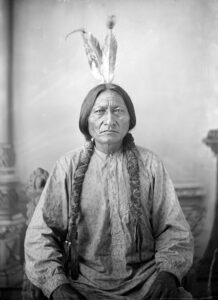 that all the Plains Indians be relocated to reservations, another source of contention. The leaders in the American government and military had hoped that the relocation could be achieved through negotiations, but in the absence of a peaceful relocation, they were perfectly willing to use violence to force the local Native Americans to comply. It was futile to fight the change, but anyone can see why the Native Americans would try. They didn’t want to be forced to stay in just one area and to be told what they could and could not do…and in reality, the reservations have not proven to be the best thing for either side. Nevertheless, that is where we are today, and in many ways, the situation hasn’t improved much, except there aren’t Indian wars, so I guess that is a good thing. The disputes are handled differently now, but the feeling of a nation inside a nation is one that really isn’t perfect. Still, the Indian Nation does exist inside the United States, and they do have jurisdiction in their own territory, and I don’t suppose the feeling of separation will ever change.
that all the Plains Indians be relocated to reservations, another source of contention. The leaders in the American government and military had hoped that the relocation could be achieved through negotiations, but in the absence of a peaceful relocation, they were perfectly willing to use violence to force the local Native Americans to comply. It was futile to fight the change, but anyone can see why the Native Americans would try. They didn’t want to be forced to stay in just one area and to be told what they could and could not do…and in reality, the reservations have not proven to be the best thing for either side. Nevertheless, that is where we are today, and in many ways, the situation hasn’t improved much, except there aren’t Indian wars, so I guess that is a good thing. The disputes are handled differently now, but the feeling of a nation inside a nation is one that really isn’t perfect. Still, the Indian Nation does exist inside the United States, and they do have jurisdiction in their own territory, and I don’t suppose the feeling of separation will ever change.
 Not every great military hero was at the top of their class at military school. George Crook graduated 38th out of a class of 43 from the United States Military Academy in 1852. Crook was born to Thomas and Elizabeth Matthews Crook on a farm near Taylorsville, Montgomery County, Ohio (near Dayton). While his classroom career was not exemplary, he was a career United States Army officer, most noted for his distinguished service during the American Civil War and the Indian Wars. During the 1880s, the Apache nicknamed Crook Nantan Lupan, which means “Chief Wolf.”
Not every great military hero was at the top of their class at military school. George Crook graduated 38th out of a class of 43 from the United States Military Academy in 1852. Crook was born to Thomas and Elizabeth Matthews Crook on a farm near Taylorsville, Montgomery County, Ohio (near Dayton). While his classroom career was not exemplary, he was a career United States Army officer, most noted for his distinguished service during the American Civil War and the Indian Wars. During the 1880s, the Apache nicknamed Crook Nantan Lupan, which means “Chief Wolf.”
Crook was commissioned in the 4th Infantry and was first stationed in Northern California, until the outbreak of the Civil War. He was appointed colonel of the 36th Ohio Infantry and they were sent immediately to western Virginia, on September 12, 1861. He was promoted to brigadier general on September 7, 1862…less than a year later. He was put in command of a brigade of regiments from Ohio during the battles of South Mountain and Antietam, both part of the Maryland Campaign. Following that campaign, Crook was given command of a cavalry division in the Army of the Cumberland under General George H Thomas. He commanded that division through the Battle of Chickamauga. Crook was sent back to western Virginia and took part in General Ulysses S Grant’s spring campaign in the spring of 1864. During the campaign, Crook successfully commanded his brigade to victory against Confederate General A G Jenkins at the Battle of Cloyd’s Mountain. Crook was given command of the Department of Western Virginia which later became the VIII Corps under General Philip Sheridan, in August of 1864. Crook commanded his men throughout many of the battles of the Valley Campaign of 1864, including the battles of Third Winchester, Fisher’s Hill, and Cedar Creek. Crook was promoted to major general on October 21, 1864 and returned to the command of his department in Cumberland, Maryland. On February 21, 1865, while located in Cumberland Maryland, General Crook along with General Benjamin F Kelley were captured by a group of Confederate partisans under the command of Captain Jesse McNeill. On March 20, 1865, Crook was freed and placed in charge of a division of cavalry in the Army of the Potomac. He commanded his division until the surrender at Appomattox Court House.
Crook fought successful campaigns during the Indian wars, against several tribes, but later went on to speak 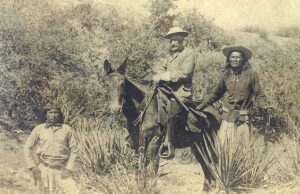 out against the unjust treatment of his former Indian adversaries. Crook was considered the Army’s preeminent Indian fighter during the Indian Wars. Even the Indians respected him. He was known to use two Apache scouts, Dutchy and Alchesay in his travels during the Indian Wars as well as his favorite mule, Apache. He died suddenly in Chicago in 1890 while serving as commander of the Military Division of the Missouri. Crook was originally buried in Oakland, Maryland, but in 1898, his remains were transported to Arlington National Cemetery, where he was reinterred. Red Cloud, a war chief of the Oglala Lakota (Sioux), said of him, “He, at least, never lied to us. His words gave us hope.” It was a great tribute.
out against the unjust treatment of his former Indian adversaries. Crook was considered the Army’s preeminent Indian fighter during the Indian Wars. Even the Indians respected him. He was known to use two Apache scouts, Dutchy and Alchesay in his travels during the Indian Wars as well as his favorite mule, Apache. He died suddenly in Chicago in 1890 while serving as commander of the Military Division of the Missouri. Crook was originally buried in Oakland, Maryland, but in 1898, his remains were transported to Arlington National Cemetery, where he was reinterred. Red Cloud, a war chief of the Oglala Lakota (Sioux), said of him, “He, at least, never lied to us. His words gave us hope.” It was a great tribute.
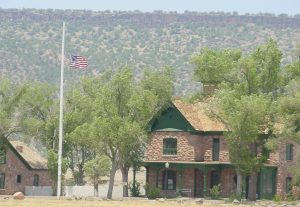
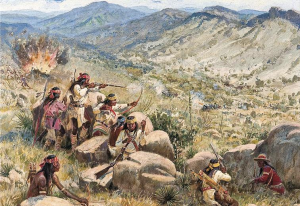 During our nation’s early years, there were many times when we found it necessary to build forts to protect the people in the area. The forts housed the armies and also took in civilians when needed. In 1870, the government built a military post four miles south of what is today, Whiteriver, Arizona. The fort was named Camp Ord, and was named after General O.C. Ord, Commander of Arizona when it was built in the spring. Just a few months later in August, the name was changed to Camp Mogollon, then Camp Thomas in September. It seems almost comical that the name would change so many times, but that was how things were done then, I guess.
During our nation’s early years, there were many times when we found it necessary to build forts to protect the people in the area. The forts housed the armies and also took in civilians when needed. In 1870, the government built a military post four miles south of what is today, Whiteriver, Arizona. The fort was named Camp Ord, and was named after General O.C. Ord, Commander of Arizona when it was built in the spring. Just a few months later in August, the name was changed to Camp Mogollon, then Camp Thomas in September. It seems almost comical that the name would change so many times, but that was how things were done then, I guess.
The post received it’s final name…Camp Apache on February 2, 1871, as a token of friendship to the Apache Indians. Ironically, the soldiers at the fort would soon spend many years at war with these same Indians they were trying to befriend. The fort’s initial purpose was to guard the nearby White Mountain Reservation and Indian agency. The fort was located at the end of a military road on the White Mountain Reservation. Right next to that was the San Carlos Agency. Both reservations would become the focus of Apache unrest, especially after troops moved the troublesome Chiricahuas from Fort Bowie to the White Mountain Reservation in 1876.
The area was in constant turmoil, mostly because the reservations were noted for their unhealthful location, overcrowded conditions, and dissatisfied inhabitants. Inefficient and corrupt agents added to the problem, and friction between civil and military authorities grew. Several attempts to turn the nomadic Indians into farmers, and an influx on the reservations of settlers and miners only added to the problem, and battles became the normal everyday event. As a result, many of the Indians left the reservations to resume their hunting, gathering, and raiding lifestyle, creating a public outcry from the settlers.
In 1871, General George Crook was named commander of the Department of Arizona. Crook had earned a reputation as an Indian fighter in the Snake War in Idaho and Oregon. Crook quickly realized that his soldiers were no match for the fierce Apache he was sent to subdue, so he made his first trip to Fort Apache. At the reservation, he recruited about fifty men to serve as Apache Scouts. These men would play a key role in the success of the Army in the Apache Wars which ensued for the next 15 years.
After recruiting the scouts, Crook prepared for his Tonto Basin campaign. Then he moved on to Camp Verde to implement his tactical operations there. During the winter of 1872-1873, Crook sent a number of mobile detachments, using Apache scouts, to crisscross the Tonto Basin and the surrounding tablelands in constant pursuit of renegade Tonto Apache and their Yavapai allies. The campaigns forcing as many as 20 skirmishes. In all some 200 Indians were killed. The battles finally began to wear down the Indians. On April 5, 1879, Camp 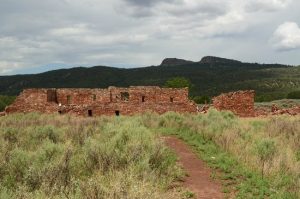
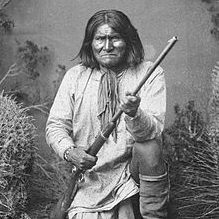 Apache had gained enough significance that it was renamed Fort Apache. The battles with the Apache continued as the soldiers fought various renegade bands that included such famous warriors as Geronimo, Natchez, Chato, and Chihuahua. It was only after Geronimo was captured for the last time in 1886, that the Apache Wars finally came to an end…and with it the need for Fort Apache. Nevertheless, it remained active until 1924. Then it was closed and the area given back to the reservation.
Apache had gained enough significance that it was renamed Fort Apache. The battles with the Apache continued as the soldiers fought various renegade bands that included such famous warriors as Geronimo, Natchez, Chato, and Chihuahua. It was only after Geronimo was captured for the last time in 1886, that the Apache Wars finally came to an end…and with it the need for Fort Apache. Nevertheless, it remained active until 1924. Then it was closed and the area given back to the reservation.
 We hear many things about the different Indian Wars and battles. We also know that many of these wars were unnecessary, and were largely due to broken treaties that were made between the White Man and the Indians. Because the population of the United States was inevitable, I don’t know how we could have possibly left so much land exclusively for the use if the Indians, but there must have been better ways to work this out. Nevertheless, once a population explosion starts, it is impossible to stop it.
We hear many things about the different Indian Wars and battles. We also know that many of these wars were unnecessary, and were largely due to broken treaties that were made between the White Man and the Indians. Because the population of the United States was inevitable, I don’t know how we could have possibly left so much land exclusively for the use if the Indians, but there must have been better ways to work this out. Nevertheless, once a population explosion starts, it is impossible to stop it.
Of further concern to the government were the spiritual beliefs of the Indians. Throughout 1890, the United States government worried about the increasing influence at Pine Ridge of the Ghost Dance spiritual movement. The movement taught that the Indians had been defeated and confined to reservations because they had angered the gods by abandoning their traditional customs. This movement prompted many Sioux Indians to believed that if they practiced the Ghost Dance and rejected the ways of the white man, the gods would create the world anew and destroy all non-believers, including non-Indians.
The situation escalated when on December 15, 1890, reservation police tried to arrest Sitting Bull, the famous Sioux chief, because they mistakenly believed he was a Ghost Dancer. In the process of his arrest, they killed him, thereby increasing the tensions at Pine Ridge. Then, on December 29, the U.S. Army’s 7th Cavalry surrounded a band of Ghost Dancers under Big Foot, a Lakota Sioux chief, near Wounded Knee Creek. They demanded the Indians surrender their weapons. Immediately, a fight broke out between an Indian and a U.S. 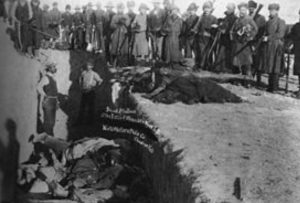 soldier. A shot was fired, but it’s unclear who fired first. A brutal massacre followed, in which it’s estimated that between 150 and 300 Indians were killed, nearly half of them women and children. The cavalry lost 25 men. The conflict at Wounded Knee was originally referred to as a battle, but in reality it was a tragic and avoidable massacre. Surrounded by heavily armed troops, it’s unlikely that Big Foot’s band would have intentionally started a fight. Some historians speculate that the soldiers of the 7th Cavalry were deliberately taking revenge for the regiment’s defeat at Little Bighorn in 1876. Whatever the motives, the massacre ended the Ghost Dance movement and was the last major battle in America’s deadly war against the Plains Indians.
soldier. A shot was fired, but it’s unclear who fired first. A brutal massacre followed, in which it’s estimated that between 150 and 300 Indians were killed, nearly half of them women and children. The cavalry lost 25 men. The conflict at Wounded Knee was originally referred to as a battle, but in reality it was a tragic and avoidable massacre. Surrounded by heavily armed troops, it’s unlikely that Big Foot’s band would have intentionally started a fight. Some historians speculate that the soldiers of the 7th Cavalry were deliberately taking revenge for the regiment’s defeat at Little Bighorn in 1876. Whatever the motives, the massacre ended the Ghost Dance movement and was the last major battle in America’s deadly war against the Plains Indians.

